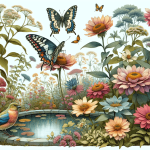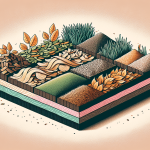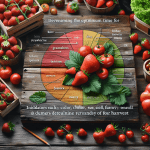This post may contain affiliate links. As an Amazon Associate, we may earn commissions from qualifying purchases.
Have you ever wondered how you could bring more harmony and productivity into your garden? By integrating livestock into your garden system, you can create a more efficient and symbiotic environment. Let’s explore the multifaceted benefits that come with this integration and how it can positively impact your ecosystem and lifestyle.
The Symphony of Animals and Plants
Enhancing Soil Fertility
One of the primary benefits of integrating livestock into your garden is the natural enhancement of soil fertility. Livestock, such as chickens, goats, and rabbits, produce manure rich in essential nutrients like nitrogen, phosphorus, and potassium. When you incorporate this manure into your garden soil, you create a robust foundation for plant growth without the need for chemical fertilizers.
Think of it this way: your garden soil is a living organism that needs to be fed, and livestock manure serves as a nutritious meal. The breakdown of manure by microorganisms further improves soil structure, helps with water retention, and promotes aeration. In short, your plants will be healthier, happier, and more productive.
Natural Pest Control
Forget the endless battle with pests that chew through your vegetables and plants. Livestock can be your frontline defense against these unwanted visitors. For instance, chickens and ducks love to forage for insects. They’ll happily devour beetles, grubs, and other pests, reducing the need for chemical pesticides.
Consider it as hiring a dedicated team of pest control experts who work tirelessly without any harmful side effects. Not only do you keep pests at bay, but your livestock also gets a healthy diet. This creates a win-win situation for both your plants and animals.
Weed Management
Weeds can be a gardener’s nightmare, but integrating livestock can help keep them in check. Goats are particularly effective at this task. They are natural foragers and can consume a wide variety of plants, including many common weeds.
By allowing goats to graze selectively in your garden, you can manage weed growth effortlessly. This manual and organic method prevents the overuse of herbicides, promoting an eco-friendly and sustainable gardening practice.
Benefits to Animals
Diverse Diet
Just as your plants receive benefits from the presence of animals, your livestock also enjoys a more varied and nutritious diet. When integrated into a garden system, animals can graze on a variety of plants, which provides them with a well-rounded diet rich in different nutrients.
This diet is particularly beneficial for their health and well-being. For instance, hens that have access to greens, insects, and other garden goodies produce eggs with more vibrant yolks and higher nutritional content.
Enriched Living Environment
Animals thrive in environments that closely replicate their natural habitats. By integrating them into a garden system, you provide a more stimulating and enriched space. Chickens love to scratch and peck, goats enjoy browsing through plants, and rabbits like to nibble on fresh greens. This behavioral enrichment improves their quality of life, leading to healthier and happier animals.
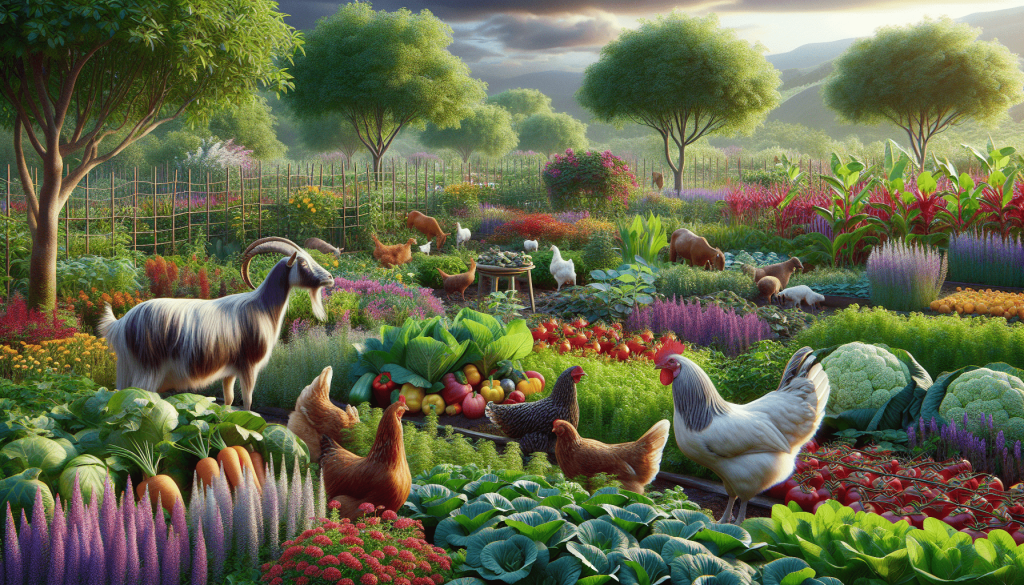
Benefits to Gardeners
Reduced Costs
A significant benefit for you as a gardener is the reduction in costs. By integrating livestock into your garden system, you rely less on external inputs like fertilizers, pesticides, and herbicides. Livestock manure provides natural fertilization, while their foraging habits control pests and weeds.
Moreover, you may also save on your feed costs. Garden produce such as vegetable scraps and surplus plants can be a valuable supplement to your livestock’s diet, reducing the need to purchase commercial feed.
Enhanced Produce
When you integrate livestock into your garden, the resulting produce is often superior in quality. Plants grown in nutrient-rich soil and without chemical pesticides are usually healthier and more flavorful. Similarly, livestock raised on diverse diets tend to produce better quality eggs, milk, or meat.
The overall quality of both your plants and animals improves, making your garden more productive and beneficial for you and your family.
Improved Sustainability
Sustainability is the buzzword of modern gardening, and integrating livestock into your system is a significant step towards achieving this goal. This practice promotes a closed-loop system where waste from one part of your garden (manure) becomes a valuable resource for another (soil fertility).
This sustainable approach reduces your carbon footprint and reliance on external resources. It fosters a more resilient and self-sufficient gardening system, making it a practical choice for eco-conscious gardeners.
Types of Livestock to Consider
Chickens
Chickens are perhaps one of the most popular choices for garden integration. They are excellent foragers, providing both pest control and manure. Chickens also produce eggs, adding another layer of productivity to your garden.
| Benefit | Details |
|---|---|
| Pest Control | Eat insects and pests |
| Soil Fertility | Provide rich manure |
| Produce | Eggs |
Ducks
Ducks are great for wet gardens or areas with a lot of water. They enjoy foraging for insects and are particularly keen on slugs and snails.
| Benefit | Details |
|---|---|
| Pest Control | Specialized in eating slugs and snails |
| Wetland Management | Help manage water-heavy areas |
| Produce | Eggs |
Goats
Goats are fantastic for weed management and can clear large areas of unwanted vegetation. They also produce milk and, in some cases, meat.
| Benefit | Details |
|---|---|
| Weed Management | Eat a variety of weeds |
| Produce | Milk and meat |
| Soil Fertility | Manure |
Rabbits
Rabbits are excellent for small gardens and can provide both manure and meat. They have a gentle impact on the garden, making them a suitable choice for delicate ecosystems.
| Benefit | Details |
|---|---|
| Soil Fertility | Provide rich manure |
| Produce | Meat |
| Gentle Impact | Suitable for small or delicate gardens |
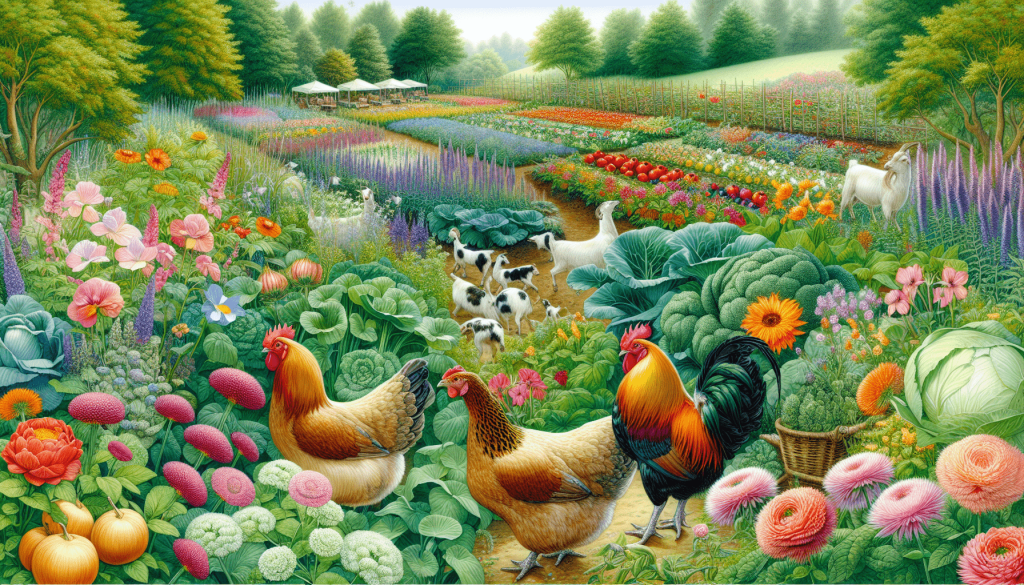
Potential Challenges and Solutions
Managing Livestock Movement
One challenge you might face is the need to control the movement of livestock within your garden. Free-roaming animals can sometimes wreak havoc on young plants or specific garden areas.
Solution: Use portable fencing or movable pens, often referred to as chicken tractors or goat arks, to control where livestock can graze. Rotational grazing ensures that different parts of your garden benefit from livestock activity without causing damage.
Balancing Manure Application
Too much of a good thing can be detrimental; this is particularly true with manure. Excessive manure can lead to nutrient imbalance and potential plant burn.
Solution: Apply manure thoughtfully and in moderation. Composting manure before adding it to your garden helps balance nutrient levels and kills any potential pathogens.
Disease and Parasites
Integrating livestock introduces the risk of disease and parasites, both for the animals and plants.
Solution: Maintain good hygiene and regular health checks for your animals. Rotate grazing areas and integrate practices such as mulching and composting to keep the garden and animals healthy. Consulting with a veterinarian for preventive treatments and vaccinations is also a good practice.
Steps to Integrate Livestock into Your Garden
Assess Your Space
Begin by evaluating your garden space and determining how much room you have to allocate to livestock. Consider both the size of your garden and the type of animals you want to integrate.
Choose Suitable Livestock
Select livestock that is appropriate for your garden size and your specific needs. Smaller gardens might benefit more from rabbits or chickens, while larger spaces can accommodate goats or ducks.
Design a Rotational Grazing System
Plan your garden layout to include sections for rotational grazing. This method helps balance the benefits of livestock without overburdening any part of your garden. Use portable fencing or movable pens to guide the grazing process.
Prepare Livestock Shelters
Ensure you have suitable shelters for your livestock to protect them from adverse weather and predators. These shelters should be easy to move if you plan to rotate their grazing areas.
Start with a Small Pilot
If you’re new to integrating livestock, begin with a small pilot system. Introduce one type of livestock to a section of your garden and observe how it interacts with your plants. This approach allows you to make adjustments before fully committing.
Your Role in the Ecosystem
In integrating livestock into your garden, you take on a new role—that of a steward overseeing a balanced ecosystem. This role is engaging and rewarding, allowing you to observe the direct impacts of your efforts on both plant and animal health.
You’ll develop a deeper understanding of the natural cycles and interdependencies within your garden. This holistic approach fosters a sense of mindfulness and appreciation for the intricate connections that sustain life.
The Joy of Integration
By integrating livestock into your garden system, you turn it into a vibrant, dynamic, and productive ecosystem. It’s a rewarding process that brings numerous benefits not just to your plants but also to your animals and you as the gardener. Reduced costs, enhanced produce quality, and improved sustainability are just the starting points.
Take the plunge and experience the joy of a more interconnected and thriving garden. Your plants will flourish, your animals will thrive, and you’ll enjoy a garden that’s richer in every sense.
Who knew that the answer to a more productive and harmonious garden lay in the gentle cluck of a chicken or the merry bleat of a goat? Now you do.

